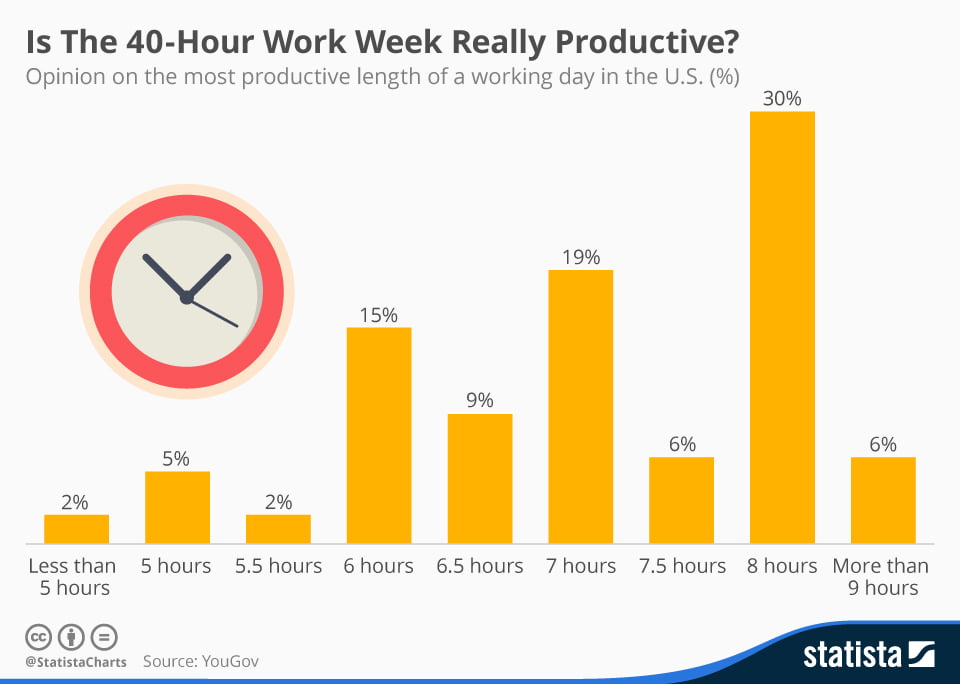
Did you know, a recent poll by YouGov found that Americans consider a workday lasting less than seven hours to be more productive?
More than 52 percent of people who were polled thought that less than seven hours was the most productive day length at the workplace. 15 percent considered six hours to be the right length to put in the daily grind.
Keep in mind that an average American works 8.7 hours a day, which means they put in 1788 hours towards their work shifts each year. Though it seems like a lot, Americans actually trail developed European countries in yearly working hours. Countries such as South Korea and Mexico work for 2163 and 2237 hours every year.
That is to say, work/life balance has been a raging topic of discussion, and more than a struggle for many countries. It’s such a big deal because it can impact just about everything from employees’ well-being and job satisfaction, to team cohesion and stress levels.
While many countries like the USA have a set standard of working hours, long work shifts are a cause of concern when it comes to employee rights. Many industries around the globe are focusing on integrating the power of automation, so they don’t need their workers to put in long hours anymore.
Concepts such as a shortened work week, though a newfound trend, are garnering attention. As a global trend, particularly in European countries, it is a radical change that is meant to ensure better employee engagement and to help workers maintain the same productivity level as during five or six working day weeks. This is where the idea of the 4-day work week comes into play.
But does it work for all people? Or how can employees complete the same amount of work in four days?
Let’s plunge into the details and see the advantages and disadvantages of a 4-day workweek.
Is a 4 Day Work Week Really Worth It?

As mentioned above, modern technology can help people get done with work faster. And that is why 5-day weeks are no longer necessary. Companies around the world are trying to implement work models with flexible schedules to help overworked employees reduce fatigue and stress levels.
Cloud HR Software, for instance, considers that paperwork handling and long spreadsheets are no longer necessary.
While the 5-day week work model used to be an effective way to get the most out of workers, it was only beneficial when factory labor was the norm.
However, technology has revolutionized everything and work shifts are no exception. Now, the idea that “longer working hours translate into higher productivity” is outdated.
Microsoft’s offices in Japan implemented a work schedule with three-day weekends, which increased productivity by 40 percent. Takuya Hirano, CEO of Microsoft Japan, further noted that workers became more attentive and took less time off after the model was introduced. The company also reduced costs with the 4-day workweek.
The technology giant found that the 4-day work week resulted in shorter meeting times and fostered remote communication.
Interestingly, Microsoft is not the only global company that experienced the advantages of the four-day workweek. Perpetual Garden, the estate planning firm in New Zealand, also tested the shortened week format. The company has eventually switched to the four-day workweek model permanently.
It doesn’t end here. Other companies, such as Buffer, also trialed the four-day week concept and experienced increased output levels.
The company gave this model a one-month trial after studying combined surveys and global proof regarding its benefits. The experiment resulted in reduced stress levels and better employee satisfaction, with no dip in productivity.
Unilever New Zealand, among other companies, rolled out the 32-hour workweek model that helped it maintain sustained productivity levels and improved work/life balance. It greatly impacted customer satisfaction, which helped in attaining company-wide goals, such as;
- individual autonomy of teammates
- lower stress levels
- worker happiness
4 Day Work Week Gaining Traction in Developed Countries

Different European countries have experimented with shorter workweeks to various degrees, and more countries in Asia and on other continents are now incorporating the four-day workweek after seeing its influential role in helping employees make efficient use of time.
Take Iceland, for example. The country provides over 80 percent of employees (in different companies) the option to work four days a week. Workers spend less time at their jobs without any reduction in pay.
The country is trying to improve employee well-being and productivity levels amidst the health crisis. The overwhelming success of the 4-day work week has also inspired other countries, such as Spain, the USA, Japan, and Finland.
As reported by The Guardian’s Ashifa Kassam, the government in Spain is all set to introduce a pilot program to try out the four-day workweek. The three-year program will allow firms to test out the 32-hour workweek schedule without reducing employee salaries.
As the concept has gained steam in many countries, Finland’s new Prime Minister, Sanna Marin, also favored the idea of a 4-day workweek. Though the idea has faced a lot of political opposition, the Prime Minister is vocal about the less-traditional workweek and the use of AI technologies to maximize output.
Japan, too, has announced a plan to introduce a four-day workweek. Japan’s annual economic policy guidelines have unveiled the country’s new recommendation that permits employees to opt for a 4-day work week. The main purpose is to increase employee satisfaction. The proposed guidelines aim to offer workers flexible schedules and remote work opportunities.
Utah, USA is on the list of states implementing a four-day workweek to increase job satisfaction among employees. In addition to enhancing employee wellbeing, the model could result in fewer work-family conflicts, according to the Utah State government.
Researchers at BYU’s Romney Institute of Public Management found that a four-day workweek also helps companies improve employee retention rates.
Some companies manage to fit the standard 40 weekly work hours into four days. Check out these examples comparing a conventional work schedule with a four-day workweek for an idea of how it works.


4 Day Week Global Foundation
The growing movement is circulating and promoting the idea of a four-day workweek among various communities. Andrew Barnes, founder of Perpetual Guardian, together with his long-term partner Charlotte Lockhart, is on a mission to get companies to change the conventional workweek to 4 days.
Both Barnes and Lockhart have been at the forefront of the shortened workweek revolution. Considering its benefits, the executives created the 4 Day Week Global Foundation. The foundation funds research on four-day workweek practices, future, and workplace well-being. Building a global coalition for the firms to adopt a four-day workweek is one of the main goals this foundation is looking to achieve.
Andrew and Charlotte have launched a global campaign to voice the concerns of people who like to work less, and support businesses to become a part of an international pilot program.
4 Day Work Week Pros and Cons
According to Future Crunch- the online future news portal, the longest trial of the four-day work week in Iceland resulted in massive success. More than one percent of the country’s working population participated in the trial and cut their weekly work to 36 hours without any pay reduction.
Deloitte, in one of the surveys, showed that 22 percent of generation Z plans to quit their companies because of workload and poor work/life balance. There is no denying that poor work-life balance has impacted talent acquisition and employee retention.
However, companies or organizations that adopted a 4-day workweek model were able to decrease stress in employees by 70 percent and increase employee satisfaction by 78 percent, according to a report by the Henley Business School. The report further found that switching to a four-day workweek helped UK businesses save £92 billion annually.
Wondering how a four–day week would work for your business? Here are some advantages and disadvantages to help you make the right decision.
Pros of the 4 Day Work Week

Reduced costs
A four-day week cuts costs for most businesses and employees. It is because the work model requires businesses to close the office for one extra day, which brings their operating costs down. Besides this, workers pay less to travel to the office and don’t have to spend money on coffee or lunch during the day.
Happier and More Satisfied Employees
With a three-day weekend, workers have more time to relax and spend on something they like to do. They have ample time to give to their families, resulting in better bonding and overall happiness.
Remember that a happier employee is more loyal to their company.
Fewer Health Problems
This might sound surprising, but more than 37 percent of businesses see a rise in the number of stress-related absences. However, when employees get a long weekend, it allows them to spend more time with family and friends, which naturally leads to improved wellbeing. It gives workers an extra lie-in every week so they can get reinvigorated after a hectic week.
Improves Productivity Levels
Discontent staff distracts co-workers, as opposed to happy and engaged employees. The general phenomenon behind this is that “a shorter week is more fulfilling for employees.” Therefore, they can focus more on their tasks when working in the workplace.
Perpetual Guardian, a firm in New Zealand, trialed a four-day workweek and found that 78 percent of employees effectively balanced their work and personal life with it. Previously, it was only 54 percent.
Hiring and Retention
It is important to understand that offering a more flexible work schedule to employees is a perk that leads to longer employee retention. It is a millennial era and people believe in multitasking. A three-day weekend offers more time to explore things and engage in growth training. This perk keeps workers motivated week-on-week.
A four-day workweek is still a rare offering. That is what makes it the best strategy to attract talent and keep it engaged.
Team Building
A four-day workweek emphasizes efficiency that brings the team closer.
As they have less time to spend in aimless discussions or disputes, the team works on the project with sheer dedication and collaboration.
Environmental Benefits
A four-day workweek reduces the individual carbon footprint of each employee by eliminating commute pollution. And it is an add-on.
More Productivity Innovations
By encouraging effective time-saving methods, workers come up with new and creative productivity hacks.
Efficient Use of Time
Let’s admit it, there is nothing sacred about a 5-day work pattern. The 40-hour workweek, in actuality, consumes more than 40 hours for most US employees.
A four-day workweek, on the other hand, requires workers to spend fewer hours on inefficient tasks. They have no time wasters, such as excessive breaks or social media time, and make the best use of their work time.
Cons of 4 Day Work Week

Doesn’t Suit All Business Models
While a four–day model works for most companies, it doesn’t benefit every business. It can be an option viable or practical for firms that can readapt operations to the new working way. It is worth mentioning that adapting your business to a new pattern is a big step and requires a significant amount of consideration.
Longer Working Hours a Day and Work-Related Stress
In reality, many employees on a four-day week are likely to work 40 hours a week due to the nature of their job. In cases like these, their shifts may extend to 10-12 hours a day. Working longer days may affect these employees’ mental health. This, in turn, has a negative impact on productivity and overall wellbeing.
What Else?
Employee Productivity Tools
If you’re considering switching to the four-day workweek model but are concerned about gauging productivity, you’ve come to the right place. Fortunately, you can use several time tracking tools to measure employee productivity. There are plenty of applications that display employees’ activity levels and work hours along with idle time.
Summing Up
All in all, more than 40 percent of USA workers prefer a 4-day workweek. The concept focuses on increasing productivity instead of spending more time in the workplace. Thus, the idea allows workers and companies to improve work-life balance, employee retention, satisfaction, and mental health.

